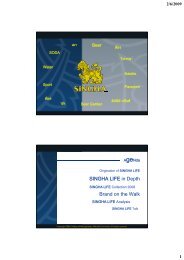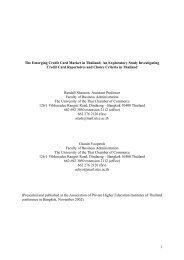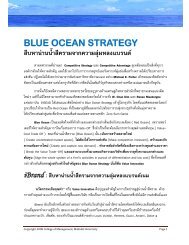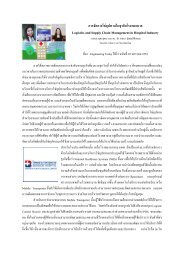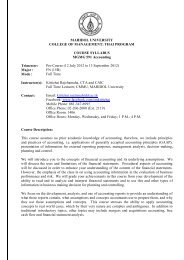Comparative Analysis of Values and Shopping Patterns Among ...
Comparative Analysis of Values and Shopping Patterns Among ...
Comparative Analysis of Values and Shopping Patterns Among ...
Create successful ePaper yourself
Turn your PDF publications into a flip-book with our unique Google optimized e-Paper software.
Page 4 <strong>of</strong> 11 <br />
(Warner, 2003). Chetthamrongchai <strong>and</strong> Davies (2000) proposed that hedonic shoppers<br />
score relatively high on present orientation, indicating that they are more concerned with<br />
what is happening now than in the past or in the future. Taken together, it is suggested<br />
that Thai shoppers will be more likely to shop for hedonic reasons.<br />
This implies that while there are many similarities between the cultures, some behavioral<br />
differences may be expected due to differing values. Chinese shoppers are cautious about<br />
spending <strong>and</strong> are less likely to make purchase during their shopping trip (Fuan et al.<br />
2004). The Chinese saying “never make a purchase until you have compared three shops”<br />
(Huo Bi San Jia) reflects the typical searching behavior <strong>of</strong> Chinese consumers, which is<br />
an example <strong>of</strong> how culture can shape consumer behavior <strong>and</strong> lead to differences between<br />
groups. China’s ruling party over the past four decades has also been extolling the virtue<br />
<strong>of</strong> thriftiness <strong>and</strong> discouraging a hedonic life style (which is viewed as self-indulgent <strong>and</strong><br />
wasteful). As a result, it is socially desirable to save money <strong>and</strong> be a meticulous shopper<br />
in China (Wang <strong>and</strong> Rao, 1995). A review <strong>of</strong> literature suggests that Chinese mall<br />
shoppers are more likely to be utilitarian driven (Tse et al., 1989; Tse, 1996; Li et al.,<br />
2004). Utilitarian shoppers tend to view shopping a work/burden rather than fun (Rao<br />
<strong>and</strong> Monroe 1989; Sherry 1990; Nicholls et al. 2000), <strong>and</strong> they are more time conscious<br />
than recreational shoppers (Hansen & Deutscher 1977/78; Bellenger <strong>and</strong> Korgaonkar,<br />
1980; Wilson <strong>and</strong> Holman 1984). Based on the literature review, the following<br />
hypotheses were developed:<br />
H1: Chinese mall shoppers will have more utilitarian shopping motives than Thai<br />
shoppers.<br />
Research Methodology<br />
A self-administered survey was employed for data collection. Self-administered surveys<br />
require comparatively lower cost <strong>and</strong> have a low level <strong>of</strong> intrusiveness (Rundle-Thiele,<br />
2005). Items to measure shopping motives were modified from the scale developed by<br />
Nicholls et al., (2000) <strong>and</strong> the result <strong>of</strong> a focus group. It consisted <strong>of</strong> three items to<br />
measure utilitarian shopping <strong>and</strong> seven items to measure hedonic/social shopping.<br />
Respondents were asked to indicate the extent to which each item described their<br />
shopping motives based on six-point Likert-type scales anchored by not at all descriptive<br />
/very descriptive. A six-point scale was utilized to avoid the common problem <strong>of</strong> Asian<br />
respondents <strong>of</strong>ten answering neutral (Ayer, 1970). Questions were translated <strong>and</strong> back<br />
translated to attain measurement equivalence for constructs (Brislin, 1976; Douglas <strong>and</strong><br />
Craig, 1983; Hui <strong>and</strong> Tri<strong>and</strong>is, 1985).<br />
The sample size for this study was determined with the use <strong>of</strong> multiple statistical<br />
guidelines. The rule <strong>of</strong> thumb suggested by Dillman (1978) <strong>and</strong> Nunnally <strong>and</strong> Bernstein<br />
(1994), requires a minimum cell size <strong>of</strong> 30 for the segmentation variable with the largest<br />
number <strong>of</strong> categories. A sample <strong>of</strong> 300 from each country was deemed to be suitable. The<br />
total number <strong>of</strong> returned questionnaires was 643, with 320 in China, <strong>and</strong> 323 in Thail<strong>and</strong>.






